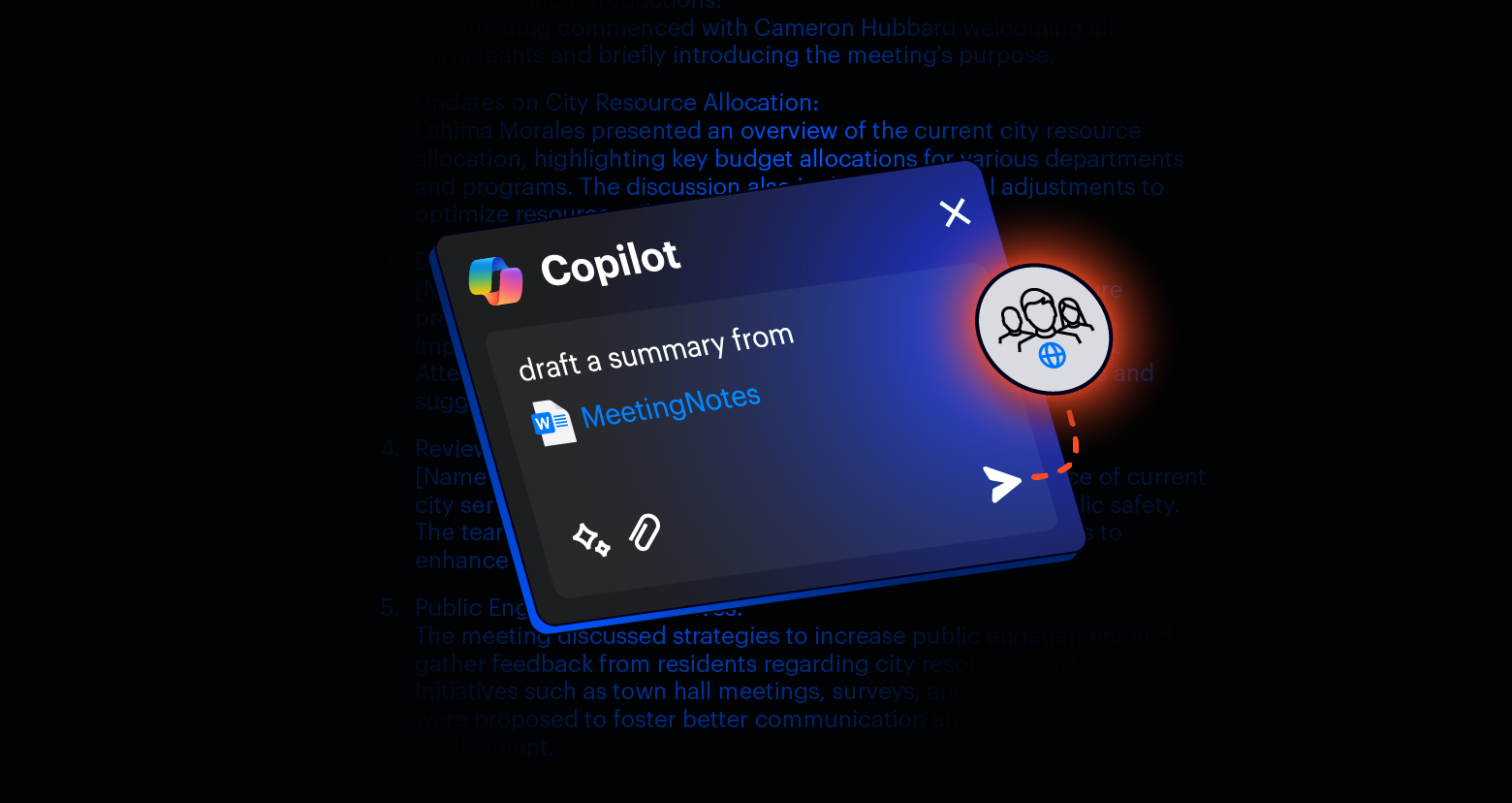Microsoft Copilot has been called one of the most powerful productivity tools on
the planet.
Copilot is an AI assistant that lives inside each of your Microsoft 365 apps — Word, Excel, PowerPoint, Teams, Outlook, and so on. Microsoft's dream is to take the drudgery out of daily work and let humans focus on being creative problem-solvers.
What makes Copilot a different beast than ChatGPT and other AI tools is that it has access to everything you've ever worked on in 365. Copilot can instantly search and compile data from across your documents, presentations, email, calendar, notes, and contacts.
And therein lies the problem for information security teams. Copilot can access all the sensitive data that a user can access, which is often far too much. On average, 10% of a company's M365 data is open to all employees.
Copilot can also rapidly generate net new sensitive data that must be protected. Prior to the AI revolution, humans' ability to create and share data far outpaced the capacity to protect it. Just look at data breach trends. Generative AI pours kerosine on this fire.
There is a lot to unpack when it comes to generative AI as a whole: model poisoning, hallucination, deepfakes, etc. In this post, however, I'm going to focus specifically on data security and how your team can ensure a safe Copilot rollout.
Microsoft 365 Copilot use cases
The use cases of generative AI with a collaboration suite like M365 are limitless. It's easy to see why so many IT and security teams are clamoring to get early access and preparing their rollout plans. The productivity boosts will be enormous.
For example, you can open a blank Word document and ask Copilot to draft a proposal for a client based on a target data set which can include OneNote pages, PowerPoint decks, and other office docs. In a matter of seconds, you have a full-blown proposal.

Here are a few more examples Microsoft gave during their launch event:
- Copilot can join your Teams meetings and summarize in real time what's being discussed, capture action items, and tell you which questions were unresolved in the meeting.
- Copilot in Outlook can help you triage your inbox, prioritize emails, summarize threads, and generate replies for you.
- Copilot in Excel can analyze raw data and give you insights, trends, and suggestions.
How Microsoft 365 Copilot works
Here's a simple overview of how a Copilot prompt is processed:
- A user inputs a prompt in an app like Word, Outlook, or PowerPoint.
- Microsoft gathers the user's business context based on their M365 permissions.
- Prompt is sent to the LLM (like GPT4) to generate a response.
- Microsoft performs post-processing responsible AI checks.
- Microsoft generates a response and commands back to the M365 app.
 Source: https://learn.microsoft.com/en-us/deployoffice/privacy/microsoft-365-copilot
Source: https://learn.microsoft.com/en-us/deployoffice/privacy/microsoft-365-copilot
Microsoft 365 Copilot security model
With collaboration tools, there is always an extreme tension between productivity and security.
This was on display during the coronavirus when IT teams were swiftly deploying Microsoft Teams without first fully understanding how the underlying security model worked or how in-shape their organization's M365 permissions, groups, and link policies were.
What Microsoft handles for you:
- Tenant isolation. Copilot only uses data from the current user's M365 tenant. The AI tool will not surface data from other tenants that the user may be a guest, in nor any tenants that might be set up with cross-tenant sync.
- Training boundaries. Copilot does not use any of your business data to train the foundational LLMs that Copilot uses for all tenants. You shouldn't have to worry about your proprietary data showing up in responses to other users in other tenants.
What you need to manage:
- Permissions. Copilot surfaces all organizational data to which individual users have at least view permissions.
- Labels. Copilot-generated content will inherit the MPIP labels of the files Copilot sourced its response from if the source files are labeled properly.
- Humans. Copilot's responses aren't guaranteed to be 100% factual or safe; humans must take responsibility for reviewing AI-generated content.
Let's take the bad news one by one.
Permissions
Granting Copilot access to only what a user can access would be an excellent idea if companies were able to easily enforce least privilege in Microsoft 365.
Microsoft states in its Copilot data security documentation:
It's important that you're using the permission models available in Microsoft 365 services, such as SharePoint, to help ensure the right users or groups have the right access to the right content within your organization.
Source: Data, Privacy, and Security for Microsoft 365 Copilot
We know empirically, however, that most organizations are about as far from least privilege as they can be. Just take a look at some of the stats from Microsoft's own State of Cloud Permissions Risk report.

This picture matches what Varonis sees when we perform thousands of Data Risk Assessments for companies using Microsoft 365 each year. In our report, The Great SaaS Data Exposure, we found that the average M365 tenant has:
- 40+ million unique permissions
- 113K+ sensitive records shared publicly
- 27K+ sharing links
Why does this happen? Microsoft 365 permissions are extremely complex. Just think about all the ways in which a user can gain access to data:
- Direct user permissions
- Microsoft 365 group permissions
- SharePoint local permissions (with custom levels)
- Guest access
- External access
- Public access
- Link access (anyone, org-wide, direct, guest)
To make matters worse, permissions are mostly in the hands of end users, not IT or security teams.
Labels
Microsoft relies heavily on sensitivity labels to enforce DLP policies, apply encryption, and broadly prevent data leaks. In practice, however, getting labels to work is difficult, especially if you rely on humans to apply sensitivity labels.
Microsoft paints a rosy picture of labeling and blocking as the ultimate safety net for your data. Reality reveals a bleaker scenario. As humans create data, labeling frequently lags behind or becomes outdated.
Blocking or encrypting data can add friction to workflows, and labeling technologies are limited to specific file types. The more labels an organization has, the more confusing it can become for users. This is especially intense for larger organizations.
The efficacy of label-based data protection will surely degrade when we have AI generating orders of magnitude more data requiring accurate and auto-updating labels.
Are my labels okay?
Varonis can validate and improve an organization's Microsoft sensitivity labeling by scanning, discovering, and fixing:
- Sensitive files without a label
- Sensitive files with an incorrect label
- Non-sensitive files with a sensitive label
Humans
AI can make humans lazy. Content generated by LLMs like GPT4 is not just good, it's great. In many cases, the speed and the quality far surpass what a human can do. As a result, people start to blindly trust AI to create safe and accurate responses.
We have already seen real-world scenarios in which Copilot drafts a proposal for a client and includes sensitive data belonging to a completely different client. The user hits "send" after a quick glance (or no glance), and now you have a privacy or data breach scenario on your hands.
Getting your tenant security-ready for Copilot
It's critical to have a sense of your data security posture before your Copilot rollout. Copilot is likely to become generally available early next year, so now is a great time to get your security controls in place.
Varonis protects thousands of Microsoft 365 customers with our Data Security Platform, which provides a real-time view of risk and the ability to automatically enforce least privilege.
Varonis for Microsoft 365 Copilot
We can help you address the biggest security risks with Copilot with virtually no manual effort. With Varonis for Microsoft 365 Copilot, you can:
-
Key features include:
- Limiting Access: Control sensitive data access to prevent unintentional exposure.
- Monitoring Prompts: Keep an eye on Copilot prompts in real-time.
- Detecting Abuse: Identify any misuse or abnormal behavior.
Additionally, Varonis offers a free Copilot Security Scan to assess your data security risks and provide actionable recommendations. We'll give you a summary of your Copilot data security risks, as well as actionable recommendations for a successful Copilot deployment, so you can confidently embrace the power of AI while maintaining security and compliance.
Ready to ensure a secure Copilot for Microsoft 365 rollout? Request your free Copilot Security Scan or start your journey right from the Azure Marketplace.
What should I do now?
Below are three ways you can continue your journey to reduce data risk at your company:
Schedule a demo with us to see Varonis in action. We'll personalize the session to your org's data security needs and answer any questions.
See a sample of our Data Risk Assessment and learn the risks that could be lingering in your environment. Varonis' DRA is completely free and offers a clear path to automated remediation.
Follow us on LinkedIn, YouTube, and X (Twitter) for bite-sized insights on all things data security, including DSPM, threat detection, AI security, and more.







-1.png)

